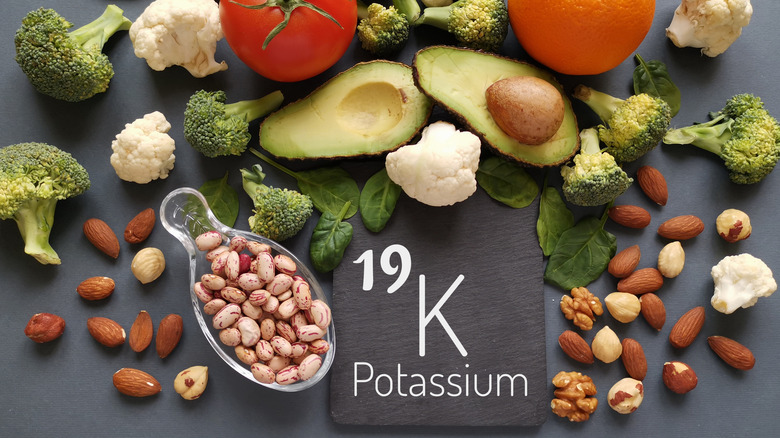How To Get Rid Of Bloating
Have you tried detox cleanses, lemon water, or low-carb diets to get rid of bloating? Unfortunately, these things rarely work. Stress, anxiety, overeating, and food sensitivities can all contribute to bloating and gas. Irritable bowel syndrome, acid reflux, Crohn's disease, and other health conditions play a role, too, explains the American Academy of Family Physicians. The only way to get a flat tummy is to determine the root cause of your problem. If, say, you always feel bloated after eating dairy, then you might have lactose intolerance. In this case, it makes sense to cut out milk, yogurt, cheese, and other dairy products.
Note that it's normal to feel bloated after eating a large meal or certain foods. For example, cruciferous veggies and legumes are known to cause gas. The same goes for chewing gum, carbonated drinks, and artificial sweeteners, says the American Academy of Family Physicians. Bloating can also be due to hormonal fluctuations — and that's why some women experience this problem before and during their periods. A diet high in fat, carbs, or sodium only makes things worse, WebMD points out.
The good news is, most people can get rid of bloating through simple lifestyle changes. Sometimes, it's enough to limit or eliminate certain foods or squeeze more exercise into your routine. Below are some tips to help you out.
Strengthen your core muscles
Bloating is often accompanied by abdominal distention. Simply put, the gas buildup can make your belly look bigger and cause discomfort. "If you overfill the GI tract, then you'll get a back up, kind of like a highway," said integrative gastroenterologist Robynne Chutkan in an interview with Health.
One way to address this problem is to get more exercise. Walking, running, strength training, and other activities speed up digestion, reducing bloating and gas. Physical activity also stimulates the production of "feel-good" hormones, which in turn may relieve stress and improve gut health, explains gastroenterologist Patricia Raymond (via Prevention).
The plank and other core exercises are particularly effective. If your core muscles are strong, your stomach won't stick out that much after eating. Bloating is often due to weak abdominal muscles, according to a 2012 review published in ISRN Gastroenterology. Researchers explain that weak core muscles, especially the internal obliques, tend to relax when they should contract. As a result, you may retain more gas and look bloated. Russian twists, side planks, trunk rotations, wood choppers, and side kicks can strengthen these muscles and flatten your tummy while improving your overall fitness.
Fill up on potassium-rich foods
High-sodium diets can lead to water retention and bloating. Just think about how you feel after eating bacon, smoked fish, or salted nuts. These foods are not necessarily unhealthy, but they can cause your body to hold excess fluid. Potassium-rich foods, on the other hand, counteract the effects of sodium and help maintain intracellular fluid volume within normal limits, explains Harvard T.H. Chan School of Public Health. The recommended daily potassium intake is 2.6 grams for adult women and 3.4 grams for adult men.
Legumes, potatoes, spinach, avocado, tomatoes, bananas, and beet greens are loaded with potassium, so you might want to include them in your diet. "Bananas are one of the best bloat fighters out there. Since they are packed with potassium and soluble fiber, they help the body flush out excess sodium and reduce inflammation. Soluble fiber also helps to relieve constipation, which can be another cause of bloat," culinary nutritionist Jenn Fillenworth told Insider.
Almonds and cashews are excellent sources of potassium, too. Just make sure you opt for low-sodium varieties. The same goes for canned beans and lentils. Other foods, such as asparagus, celery, and artichokes, boast a mild diuretic effect and can help you get rid of bloating. For example, asparagus contains asparagine — an amino acid with diuretic properties — and prebiotics, which support digestive health. Therefore, it can balance your gut flora and help flush out excess water, notes wellness expert Dr. Jacqueline Schaffer (via Insider).
Try an elimination diet to get rid of bloating
The best way to get rid of bloating is to figure out what's causing it in the first place. An elimination diet can help you identify sensitivities and intolerances to common foods such as milk, eggs, or wheat. For example, people with fructose intolerance may experience gas, bloating, stomach pain, and digestive distress after eating foods containing this sugar. If that's the case, you may need to cut out fruits, honey, and high fructose corn syrup. Sorbitol, a sugar alcohol, should be avoided as well, according to Medical News Today.
Precision Nutrition recommends eliminating one to four foods for three weeks to see how your body reacts. Another option is to cut out just one food or food group. If, say, you suspect you're sensitive to dairy, eliminate milk and its derivatives from your diet. If you're not sure whether you are sensitive to gluten or dairy, then you should cut out both food groups for three weeks. After that, you may introduce them back into your diet, one at a time. If your symptoms flare up after you reintroduce a specific food, then it's best to avoid it as much as possible.
Keep a food journal to track your progress. If you don't experience bloating or other symptoms for at least five days, you may begin the reintroduction phase, says the University of Wisconsin-Madison. Note that you may need to repeat these steps until you identify the culprits.



